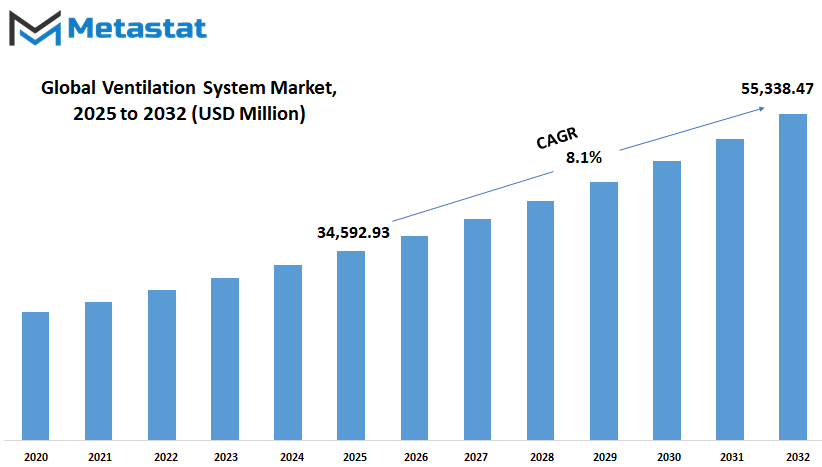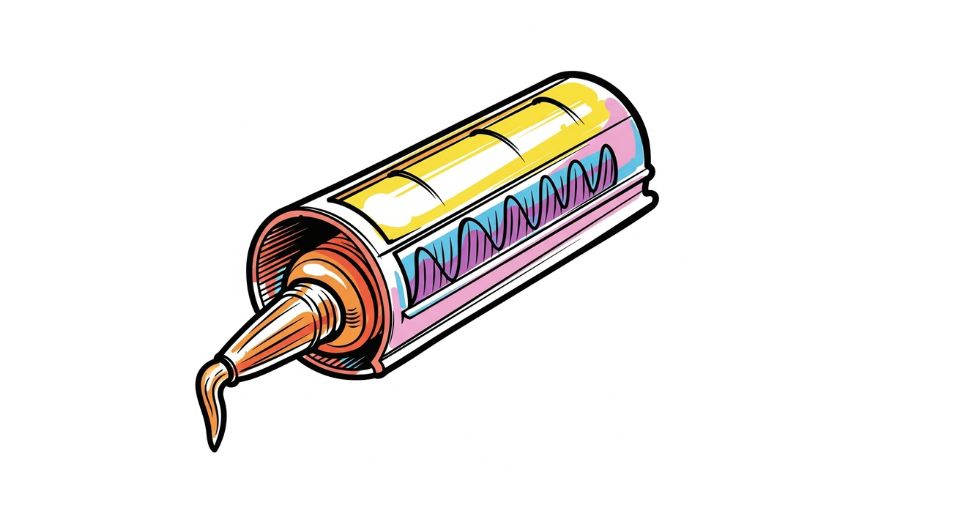MARKET OVERVIEW
The Global Ventilation System market, in the building technologies and environmental control field, will be the benchmark for indoor air management in residential, commercial, and industrial markets. The market will revolve around engineered solutions allowing air circulation, filtration, and humidity control engineered to improve air quality and maintain comfort while achieving safety and energy consumption requirements. With more focus on indoor air quality standards, the Global Ventilation System market will be a key technology segment in defining how buildings function.
Ventilation systems are not just about moving air; they will increasingly be part of overall energy and automation systems. In the Global Ventilation System market, innovation will trend towards modular systems that will interact with building management technologies to bring dynamic responses to occupancy, pollution sensing, and thermal loads. The solutions won't exist in isolation but will interact with data-driven infrastructure to deliver optimal control of airflow and contaminant removal in real time. The Global Ventilation System market will transform from single, mechanical units to intelligent systems that enable long-term sustainability and accuracy of operations.
The Global Ventilation System market will be fueled by performance specifications varying by regions, building codes, and climatic conditions. The Global Ventilation System market will therefore require manufacturers and engineers to customize solutions according to unique functional, geographic, and regulatory considerations. In very densely populated city environments, for instance, tightly packaged systems with low noise output and maximum filtration efficiency will be required. Bulk manufacturing plants, however, will require industrial-grade systems with repeatable performance in the face of unpredictable temperature and particle loading conditions.
Materials technology and sensor integration will characterize the way systems evolve in the Global Ventilation System market. Sensors to detect fine particulate, CO₂ concentrations, and VOCs will be built into ventilation equipment so that system adjustment automatically will be done according to real-time readings of air quality. These embedded technologies will allow proactive rather than reactive control of air, enabling healthier environments in both occupant health and energy savings.
Maintenance routines will also influence the mode of operation in the Global Ventilation System industry. Predictive analytics and remote diagnostics will provide less system downtime and extended device life. The facility manager will utilize data dashboarding to monitor airflow consistency, pressure, and filter integrity. This integration of monitoring software on mechanical ventilation structures will reduce operations uncertainty and optimize energy inputs.
Product design within the Global Ventilation System industry will be driven by higher requirements for design adaptability, smart control, and sustainability. Industry players will employ sophisticated fan motors, adaptable ducting solutions, and sound control technology that accommodates diversified architectural and environmental specifications. Although energy efficiency remains a critical performance factor, the systems will come up with innovative ways to accommodate green building certification standards without compromising air quality standards.
Over the years, the Global Ventilation System market will continue to be a major catalyst in shaping the architectural mindset. It will respond to technological requirements as well as evolving social needs in terms of health, safety, and climate vulnerability. Ventilation technology will change from the exchange of air to emerging as a strategic process incorporated into intelligent infrastructure around the world as convergence with other building systems intensifies.
Global Ventilation System market is estimated to reach $55,338.47 Million by 2032; growing at a CAGR of 8.1% from 2025 to 2032.

GROWTH FACTORS
The Global Ventilation System market is gradually emerging With growing worldwide interest in healthier living environments and green building practices,. There is a discernible trend towards designing and running buildings differently, and better indoor air quality has become the focal point. People are becoming aware of the influence that air quality has on their health, comfort, and performance. Therefore, there is an increased demand for systems that will supply fresh and clean air in indoor environments, especially in residential spaces, offices, and public buildings. This increased awareness is bound to have a big impact on the development of ventilation solutions in the future. The move towards energy-efficient technologies is another major aspect that will influence the development of the Global Ventilation System market.
With added pressure on sustainability and reduced carbon emissions, more facility managers and contractors are looking for ways to reduce energy consumption and maintain good airflow. Less energy-consuming ventilation systems that offer quality airflow are in demand. Governments and green groups are also encouraging the use of such systems with energy-saving-friendly policies and building regulations. However, the market does have certain problems that will slow its progress. The initial one is that the installation of advanced ventilation systems is an expensive initial outlay.
For the majority of building proprietors, and especially those with older structures, the initial expense is often a significant discouragement. Furthermore, installing new buildings with advanced ventilation systems typically requires wholesale structural changes. This is an expensive and invasive process, though, that can be difficult for some property owners to undertake. These issues apart, the future of the Global Ventilation System market is promising, especially with the advent of smart technology. The introduction of intelligent systems, which are able to adjust settings automatically depending on the air quality and the number of people in the building, is poised to change the nature of airflow within buildings. They are able to make the buildings more efficient in terms of energy use and offer healthy spaces without the necessity of continuous human intervention. The direction that the Global Ventilation System market is heading has a very high growth potential rate, which is being fueled by both green and technological developments.
MARKET SEGMENTATION
By Type
The Global Ventilation System market will keep expanding steadily as the need for healthier indoor environments becomes an increasing priority in the coming years. As people become more aware of how air influences daily life, homes and companies will require improved airflow. This shift will not be solely about comfort but also about safety and health. Ventilation systems help to conserve indoor air by adding clean air and removing stale or dirty air. More advanced forms of these systems will be designed in the future to meet changing demands in different types of buildings.
By Type, the World Ventilation System market will continue with obvious segmentation. Wall-Mount Type systems are often chosen for ease of installation and limited space needs. These are employed in smaller-sized rooms or houses where floor space is limited. They offer an effortless, yet effective means of improving air circulation without requiring huge structural changes. Ceiling-Mount Type systems, however, find extensive use for larger areas or where a similar airflow is necessary throughout the entire area. These are usually made to be blended into the visual environment, and therefore they are a perfect answer where looks and aesthetic appeal take precedence. With future-proofed smart buildings, future ceiling-mount systems would probably also self-adjust air flow based on how many people occupy an area or even the air's quality level. Cabinet-Mount Type units are more complex and are implemented where higher performance is required, such as with industrial use or major commercial sites. These units can avail themselves of future advances in energy efficiency and digital control and will be wiser and cost-saver over the long run.
Driving the Global Ventilation System market ahead is not merely a desire for comfort but rising health issues, especially in city centres where air quality is growing more polluted. Governments, architects, and engineers will increasingly enforce stricter codes that require higher ventilation levels in new construction and retrofits to existing buildings. As the market expands, equipment will get quieter, more energy-efficient, and easier to service. Humans will want systems that respond automatically to their needs, and companies will create products that offer such flexibility. Over time, the Global Ventilation System market will grow even larger, driven by technology and the need for cleaner indoor spaces.
By Product
The Global Ventilation System market will grow steadily as industries, residences, and public buildings increasingly value indoor air quality and energy efficiency. As awareness of health and comfort grows, the need for dependable air circulation systems is on the rise. In the future, this market will remain in the spotlight as individuals seek improved means of controlling indoor environments. This increased interest will determine the way that products are installed, designed, and maintained. The trend toward more intelligent, networked systems will also lead to new possibilities, particularly in buildings that are being renovated to current standards.
By product, the market is defined by various forms of ventilation equipment, which have their individual functions. Ventilation fans will continue to play a central role in fundamental air movement in buildings. They are frequently utilized to exhaust stale air and maintain indoor environments free from stale air. In the years to come, these fans will be engineered to be more efficient and quieter, which will render them even more attractive to homes and companies. Air handling units are yet another vital component of the system. They serve to control temperature, humidity, and air purity. These systems will be more sophisticated, employing sensors and automation to regulate settings based on the space's requirements, resulting in improved energy utilization and greater occupant comfort.
Air cleaners will likewise experience increased demand, particularly in urban areas where air pollution continues to increase. They will have a larger role to play in purifying the air by eliminating particles, allergens, and toxic gases. With advancements in technology, air purifiers will become more capable of serving larger areas, operating more quickly, and using less energy. Ventilation controls will connect all the products together. Ventilation systems assist in monitoring and modifying air flow depending on how the building is occupied. Smart technology will assist them to be more responsive by automatically responding to occupancy changes, weather, and other factors. This will assist in reducing energy consumption by consumers and making indoor areas cleaner.
The Global Ventilation System market will keep evolving as new materials, construction methods, and climate issues impact product design. Ventilation will no longer be solely about moving air it will be about designing a living or working space that optimizes health and performance. The emphasis will be on creating wiser, more efficient, and more convenient systems while maintaining the air as clean and comfortable as possible.
By Technology
The Global Ventilation System market is headed towards great change with greater stress being placed on healthier and energy-efficient indoor conditions. This change is being driven by an increasingly growing wish to improve the quality of indoor air in residential and commercial complexes. With health awareness regarding the impact of indoor air on well-being on the rise, demand for improved ventilation systems continues to grow. Developers, engineers, and facilities managers are ever more concentrating on how air circulates in buildings, and technology used to control it is under more scrutiny than ever.
The future of the Global Ventilation System market will be determined by technological growth and changing building codes in the future. Expansion is seen largely in the use of mechanical ventilation systems. These systems use ducts and fans to bring in fresh air and remove stale air. As smart building technology advances, such systems are becoming increasingly efficient. These systems can adjust airflow based on real-time data, such as how many people are in a room or humidity levels. Not only is energy saved but also a healthier and more comfortable indoor climate is provided.
Natural ventilation is also becoming more fashionable again, especially with more architects focusing on sustainability. This method involves the use of windows, vents, and other openings to introduce clean air through a space without the assistance of machinery. In areas where weather permits, natural ventilation can be cheap and green. Its success does, however, depend quite heavily on outdoor conditions and building design, so it may not be appropriate for all situations.
Hybrid ventilation will also play a bigger role in the future. It is beneficial for both mechanical and natural systems. During good weather, buildings can utilize natural ventilation more, and when it becomes extreme, mechanical systems take over. The system is adaptable, reduces energy usage, and preserves air quality without compromise. With increasing building codes and increasing energy demands, it is quite possible that developers will find more hybrid systems appealing.
In total, the Global Ventilation System market is poised for steady expansion. The demands to cut back on energy consumption, address environmental objectives, and enhance air quality will keep driving the creation of wiser and more adaptable ventilation solutions. As new structures emerge and existing ones undergo renovation, ventilation systems will play a fundamental role in dictating the way people live and work in the future.
By Application
The Ventilation System Market is growing in significance as humans are increasingly focusing on the quality of air within their environment. As urbanization increases and health and comfort awareness increases, the demand for effective ventilation has expanded to multiple spaces. From home to office or factory, effective air circulation is crucial in ensuring people are safe and productive. In the coming years, this market is bound to increase on the back of both technological advancements and ecological issues. As the world progresses, demand will not only be on bringing in fresh air but also on how systems are able to do so in intelligent and more efficient manners.
In the future, houses will be built with more intelligent systems that can modulate airflow according to time or occupants in a room. The systems will become increasingly integrated into other devices at home, with greater control and energy efficiency. In the domestic segment, the Global Ventilation System market will be helped by individuals demanding a healthy indoor environment. Systems that are able to filter out dangerous particles and control humidity will be in the spotlight. Families will demand features that are simple to operate, affordable, and low maintenance. As more people adopt compact living spaces, smart ventilation will also serve to make smaller homes feel more spacious and airy.
In commercial environments, ventilation will remain a critical component of making buildings comfortable and safe for employees and visitors. The business aspect of the Global Ventilation System market will expand as office space, malls, and schools set their sights on a cleaner indoor environment. Demand will rise for systems that can adapt to air quality readings and usage. As more businesses embrace technology, ventilation will be an integral part of larger smart building systems that reduce energy consumption and enhance comfort.
Industrial areas will need more robust and more dependable ventilation because of the kind of work that is done in these environments. Factories and warehouses handle heat, dust, and chemical fumes, so systems need to be able to withstand tough conditions. Industries in the future will probably employ more sophisticated systems that not only purify the air but also assist in monitoring conditions in real time. This will enhance worker safety and assist companies in complying with environmental regulations.
In total, the Global Ventilation System market will keep expanding in all three applications. It will trend toward more intelligent, more environmentally friendly, and more efficient designs, bringing clean air more within reach and dependable for all.
|
Forecast Period |
2025-2032 |
|
Market Size in 2025 |
$34,592.93 million |
|
Market Size by 2032 |
$55,338.47 Million |
|
Growth Rate from 2025 to 2032 |
8.1% |
|
Base Year |
2024 |
|
Regions Covered |
North America, Europe, Asia-Pacific, South America, Middle East & Africa |
REGIONAL ANALYSIS
The Ventilation System market globally will keep on growing as the world's need for clean air and improved indoor air quality rises. This is particularly true as more individuals move into cities and spend most of their time indoors. The government is also emphasizing health standards, compelling industries and residential complexes to fit more efficient ventilation systems. Technology will have a large role in deciding how these systems are constructed and utilized in the future, with intelligent sensors and automation assisting in decreasing energy consumption and increasing performance. Although the overall market is expanding, its advancement is not equal in all areas.
In North America, particularly in the United States and Canada, demand for sophisticated ventilation systems is likely to increase as buildings become more energy efficient. This trend is also fueled by more stringent regulations and growing awareness of the long-term health implications of poor air quality. Mexico is slowly catching up, with urbanization and industrialization contributing to increasing demand. Europe too is witnessing steady momentum, especially among nations such as Germany and the UK, as stringent environmental legislation and public sensitivity continue to strive for cleaner air indoors. There is interest on the part of France and Italy too, supported by renovation in buildings and remodeling older buildings.
Asia-Pacific is seeing brisk development in countries such as India and China that is propelling large-scale urban planning and building needs, which will incorporate advanced ventilation systems. With the increase in city growth and pollution a constant issue, the emphasis on clean air products is gaining force. South Korea and Japan already lead the use of smart technology in buildings, and this trend will extend into neighboring markets. The rest of the Asia-Pacific countries will in turn follow in the future, particularly as economic development enables greater investment in infrastructure.
South America is experiencing slow, but consistent development. Argentina and Brazil are the major nations where infrastructure development is taking place, and government buildings are starting to incorporate improved systems. The Middle East and Africa region is also showing evidence of development, primarily driven by the GCC nations, where heat requires improved circulation of air. Egypt and South Africa are bound to invest further as indoor air quality awareness is spreading.
In the future, every region will tend to concentrate on particular needs—be it energy efficiency, health issues, or climate control—which will define how the global Ventilation System market develops and evolves over time.

COMPETITIVE PLAYERS
The Global Ventilation System market will expand further as there is growing demand across residential, commercial, and industrial segments. Complemented by health considerations, energy efficiency standards, and stricter environmental regulations, adoption of intelligent, flexible ventilation systems is spreading. Innovations will not just address the aspect of improving indoor air quality but also enhancing the energy utilization and embedding intelligent control systems that respond automatically to shifts in the environment. This change will define the design and management of buildings in the future, driving the industry towards more responsive and sustainable technologies.
One of the key drivers of this change will be the top companies that are continually striving to enhance and develop their products. These companies, such as Daikin, Honeywell International Inc., and Johnson Controls International plc, are well placed to drive the future of ventilation systems. They spend a lot on research and development to bring in systems that do more than move air around. They are now concentrating on solutions that monitor air quality, modulate temperature and humidity, and integrate well with other building systems. This degree of integration will be instrumental in making buildings healthier and more efficient.
Mitsubishi Electric Corporation, LG Electronics Inc., and Samsung Electronics Co., Ltd. are also vying aggressively to introduce more user-friendly, intelligent systems into the marketplace. Their capacity for merging electronics and smart elements into ventilation products sets them apart as customers and corporations look for comfort, convenience, and enhanced performance. These organizations will shape the way forward in the industry by offering sophisticated systems at scale.
At the same time, organizations such as Schneider Electric SE, Carrier Global Corporation, and Siemens AG are adding their knowledge of energy management and automation. As buildings become more networked, these systems will not only control airflow but also assist in monitoring energy consumption, minimize carbon emissions, and facilitate regulatory compliance. Their participation ensures that future ventilation solutions will be compatible with worldwide climate objectives.
Other companies like Zehnder Group AG, Systemair AB, and Trane Technologies plc continue to craft niche and bespoke solutions. Their ability to adapt means that they are able to provide distinct customer requirements, especially for rooms that need precise air standards. With health and air purity increasingly becoming a concern in public and private buildings, these specialist offerings will prove increasingly valuable.
As a whole, the Global Ventilation System market will experience enhanced synergy between environmental technologies, automation, and electronics. Competitor players will steer this advancement by concentrating on smart living, innovation, and sustainability through smarter ventilation.
Ventilation System Market Key Segments:
By Type
- Wall-Mount Type
- Ceiling-Mount Type
- Cabinet-Mount Type
By Product
- Ventilation Fans
- Air Handling Units
- Air Purifiers
- Ventilation Controls
By Technology
- Mechanical Ventilation
- Natural Ventilation
- Hybrid Ventilation
By Application
- Residential
- Commercial
- Industrial
Key Global Ventilation System Industry Players
- Daikin
- Johnson Controls International plc
- Siemens AG
- Honeywell International Inc.
- LG Electronics Inc.
- Carrier Global Corporation
- Mitsubishi Electric Corporation
- Trane Technologies plc
- Schneider Electric SE
- Panasonic Corporation
- Samsung Electronics Co., Ltd.
- Rosenberg Ventilatoren GmbH & Co. KG
- Zehnder Group AG
- Systemair AB
- S&P Sistemas de Ventilación S.L.
- Vortice S.p.A.
- Maico Elektroapparate-Fabrik GmbH
- Helios Ventilatoren GmbH + Co KG
- Midea Group Co., Ltd.
WHAT REPORT PROVIDES
- Full in-depth analysis of the parent Industry
- Important changes in market and its dynamics
- Segmentation details of the market
- Former, on-going, and projected market analysis in terms of volume and value
- Assessment of niche industry developments
- Market share analysis
- Key strategies of major players
- Emerging segments and regional growth potential








 US: +1 3023308252
US: +1 3023308252






